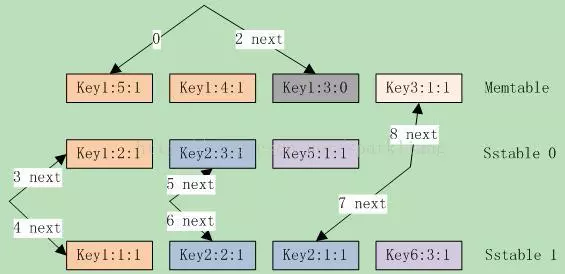 leveldb源码分析21
leveldb源码分析21
# leveldb源码分析21
本系列《leveldb源码分析》共有22篇文章,这是第二十一篇
# 14 DB的查询与遍历之1
分析完如何打开和关闭db,本章就继续分析如何从db中根据key查询value,以及遍历整个db。
# 14.1 Get()
函数声明:StatusGet(const ReadOptions& options, const Slice& key, std::string* value) 从DB中查询key 对应的value,参数@options指定读取操作的选项,典型的如snapshot号,从指定的快照中读取。快照本质上就是一个sequence号,后面将单独在快照一章中分析。 下面就来分析下函数逻辑:
// S1 锁mutex,防止并发,如果指定option则尝试获取snapshot;然后增加MemTable的引用值。
MutexLock l(&mutex_);
SequenceNumber snapshot;
if (options.snapshot != NULL)
snapshot = reinterpret_cast<const SnapshotImpl*>(options.snapshot)->number_;
else snapshot = versions_->LastSequence(); // 取当前版本的最后Sequence
MemTable *mem = mem_, *imm = imm_;
Version* current = versions_->current();
mem->Ref();
if (imm != NULL) imm->Ref();
current->Ref();
// S2 从sstable文件和MemTable中读取时,释放锁mutex;之后再次锁mutex。
bool have_stat_update = false;
Version::GetStats stats;
{
mutex_.Unlock();
// 先从memtable中查询,再从immutable memtable中查询
LookupKey lkey(key, snapshot);
if (mem->Get(lkey, value, &s)) {
}
else if (imm != NULL && imm->Get(lkey, value, &s)) {
}
else { // 需要从sstable文件中查询
s = current->Get(options, lkey, value, &stats);
have_stat_update = true; // 记录之,用于compaction
}
mutex_.Lock();
}
// S3 如果是从sstable文件查询出来的,检查是否需要做compaction。最后把MemTable的引用计数减1。
if (have_stat_update &¤t->UpdateStats(stats)) {
MaybeScheduleCompaction();
}
mem->Unref();
if (imm != NULL)imm->Unref();
current->Unref();
2
3
4
5
6
7
8
9
10
11
12
13
14
15
16
17
18
19
20
21
22
23
24
25
26
27
28
29
30
31
32
33
34
35
查询是比较简单的操作,UpdateStats在前面Version一节已经分析过。
# 14.2 NewIterator()
函数声明:Iterator*NewIterator(const ReadOptions& options) 通过该函数生产了一个Iterator*对象,调用这就可以基于该对象遍历db内容了。 函数很简单,调用两个函数创建了一个二级Iterator。
Iterator* DBImpl::NewIterator(const ReadOptions& options) {
SequenceNumber latest_snapshot;
Iterator* internal_iter = NewInternalIterator(options, &latest_snapshot);
returnNewDBIterator(&dbname_, env_, user_comparator(), internal_iter,
(options.snapshot != NULL
? reinterpret_cast<constSnapshotImpl*>(options.snapshot)->number_
: latest_snapshot));
}
2
3
4
5
6
7
8
其中,函数NewDBIterator直接返回了一个DBIter指针
Iterator* NewDBIterator(const std::string* dbname, Env* env,
const Comparator*user_key_comparator, Iterator* internal_iter,
const SequenceNumber& sequence) {
return new DBIter(dbname, env, user_key_comparator, internal_iter, sequence);
}
2
3
4
5
函数NewInternalIterator有一些处理逻辑,就是收集所有能用到的iterator,生产一个Merging Iterator。这包括MemTable,Immutable MemTable,以及各sstable。
Iterator* DBImpl::NewInternalIterator(const ReadOptions& options,
SequenceNumber*latest_snapshot) {
IterState* cleanup = newIterState;
mutex_.Lock();
// 根据last sequence设置lastest snapshot,并收集所有的子iterator
*latest_snapshot = versions_->LastSequence();
std::vector<Iterator*>list;
list.push_back(mem_->NewIterator()); // >memtable
mem_->Ref();
if (imm_ != NULL) {
list.push_back(imm_->NewIterator()); // >immutablememtable
imm_->Ref();
}
versions_->current()->AddIterators(options, &list); // >current的所有sstable
Iterator* internal_iter = NewMergingIterator(&internal_comparator_, &list[0], list.size());
versions_->current()->Ref();
// 注册清理机制
cleanup->mu = &mutex_;
cleanup->mem = mem_;
cleanup->imm = imm_;
cleanup->version = versions_->current();
internal_iter->RegisterCleanup(CleanupIteratorState, cleanup, NULL);
mutex_.Unlock();
return internal_iter;
}
2
3
4
5
6
7
8
9
10
11
12
13
14
15
16
17
18
19
20
21
22
23
24
25
这个清理函数CleanupIteratorState是很简单的,对注册的对象做一下Unref操作即可。
static void CleanupIteratorState(void* arg1, void* arg2) {
IterState* state = reinterpret_cast<IterState*>(arg1);
state->mu->Lock();
state->mem->Unref();
if (state->imm != NULL)state->imm->Unref();
state->version->Unref();
state->mu->Unlock();
delete state;
}
2
3
4
5
6
7
8
9
可见对于db的遍历依赖于DBIter和Merging Iterator这两个迭代器,它们都是Iterator接口的实现子类。
# 14.3 MergingIterator
MergingIterator是一个合并迭代器,它内部使用了一组自Iterator,保存在其成员数组children_中。如上面的函数NewInternalIterator,包括memtable,immutable memtable,以及各sstable文件;它所做的就是根据调用者指定的key和sequence,从这些Iterator中找到合适的记录。 在分析其Iterator接口之前,先来看看两个辅助函数FindSmallest和FindLargest。FindSmallest从0开始向后遍历内部Iterator数组,找到key最小的Iterator,并设置到current_;FindLargest从最后一个向前遍历内部Iterator数组,找到key最大的Iterator,并设置到current_; MergingIterator还定义了两个移动方向:kForward,向前移动;kReverse,向后移动。
# 14.3.1 Get系接口
下面就把其接口拖出来一个一个分析,首先是简单接口,key和value都是返回current_的值,current_是当前seek到的Iterator位置。
virtual Slice key() const {
assert(Valid());
return current_->key();
}
virtual Slice value() const {
assert(Valid());
return current_->value();
}
virtual Status status() const {
Status status;
for (int i = 0; i < n_; i++) { // 只有所有内部Iterator都ok时,才返回ok
status = children_[i].status();
if (!status.ok()) break;
}
return status;
}
2
3
4
5
6
7
8
9
10
11
12
13
14
15
16
17
18
# 14.3.2 Seek系接口
然后是几个seek系的函数,也比较简单,都是依次调用内部Iterator的seek系函数。然后做merge,对于Seek和SeekToFirst都调用FindSmallest;对于SeekToLast调用FindLargest。
virtual void SeekToFirst() {
for (int i = 0; i < n_; i++) children_[i].SeekToFirst();
FindSmallest();
direction_ = kForward;
}
virtual void SeekToLast() {
for (int i = 0; i < n_; i++) children_[i].SeekToLast();
FindLargest();
direction_ = kReverse;
}
virtual void Seek(constSlice& target) {
for (int i = 0; i < n_; i++) children_[i].Seek(target);
FindSmallest();
direction_ = kForward;
}
2
3
4
5
6
7
8
9
10
11
12
13
14
15
16
17
# 14.3.3 逐步移动
最后就是Next和Prev函数,完成迭代遍历。这可能会有点绕。下面分别来说明。 首先,在Next移动时,如果当前direction不是kForward的,也就是上一次调用了Prev或者SeekToLast函数,就需要先调整除current之外的所有iterator,为什么要做这种调整呢?啰嗦一点,考虑如下的场景,如图14.3-1所示。

图14.3-1 Next的移动
当前direction为kReverse,并且有:Current = memtable Iterator。各Iterator位置为:{memtable, stable 0, sstable1} ={ key3:1:1, key2:3:1, key2:1:1},这符合prev操作的largest key要求。 注:需要说明下,对于每个update操作,leveldb都会赋予一个全局唯一的sequence号,且是递增的。例子中的sequence号可理解为每个key的相对值,后面也是如此。 接下来我们来分析Prev移动的操作。 第一次Prev,current(memtable iterator)移动到key1:3:0上,3者中最大者变成sstable0;因此current修改为sstable0; 第二次Prev,current(sstable0 Iterator)移动到key1:2:1上,3者中最大者变成sstable1;因此current修改为sstable1: 此时各Iterator的位置为{memtable, sstable 0, sstable1} = { key1:3:0, key1:2:1, key2:2:1},并且current=sstable1。 接下来再调用Next,显然当前Key()为key2:2:1,综合考虑3个iterator,两次Next()的调用结果应该是key2:1:1和key3:1:1。而memtable和sstable0指向的key却是key1:3:0和key1:2:1,这时就需要调整memtable和sstable0了,使他们都定位到Key()之后,也就是key3:1:1和key2:3:1上。 然后current(current1)Next移动到key2:1:1上。这就是Next时的调整逻辑,同理,对于Prev也有相同的调整逻辑。代码如下:
virtual void Next() {
assert(Valid());
// 确保所有的子Iterator都定位在key()之后.
// 如果我们在正向移动,对于除current_外的所有子Iterator这点已然成立
// 因为current_是最小的子Iterator,并且key() = current_->key()。
// 否则,我们需要明确设置其它的子Iterator
if (direction_ != kForward) {
for (int i = 0; i < n_; i++) { // 把所有current之外的Iterator定位到key()之后
IteratorWrapper* child = &children_[i];
if (child != current_) {
child->Seek(key());
if (child->Valid() && comparator_->Compare(key(), child->key()) == 0)
child->Next(); // key等于current_->key()的,再向后移动一位
}
}
direction_ = kForward;
}
// current也向后移一位,然后再查找key最小的Iterator
current_->Next();
FindSmallest();
}
virtual void Prev() {
assert(Valid());
// 确保所有的子Iterator都定位在key()之前.
// 如果我们在逆向移动,对于除current_外的所有子Iterator这点已然成立
// 因为current_是最大的,并且key() = current_->key()
// 否则,我们需要明确设置其它的子Iterator
if (direction_ != kReverse) {
for (int i = 0; i < n_; i++) {
IteratorWrapper* child = &children_[i];
if (child != current_) {
child->Seek(key());
if (child->Valid()) {
// child位于>=key()的第一个entry上,prev移动一位到<key()
child->Prev();
}
else { // child所有的entry都 < key(),直接seek到last即可
child->SeekToLast();
}
}
}
direction_ = kReverse;
}
//current也向前移一位,然后再查找key最大的Iterator
current_->Prev();
FindLargest();
}
2
3
4
5
6
7
8
9
10
11
12
13
14
15
16
17
18
19
20
21
22
23
24
25
26
27
28
29
30
31
32
33
34
35
36
37
38
39
40
41
42
43
44
45
46
47
48
这就是MergingIterator的全部代码逻辑了,每次Next或者Prev移动时,都要重新遍历所有的子Iterator以找到key最小或最大的Iterator作为current_。这就是merge的语义所在了。 但是它没有考虑到删除标记等问题,因此直接使用MergingIterator是不能正确的遍历DB的,这些问题留待给DBIter来解决。
